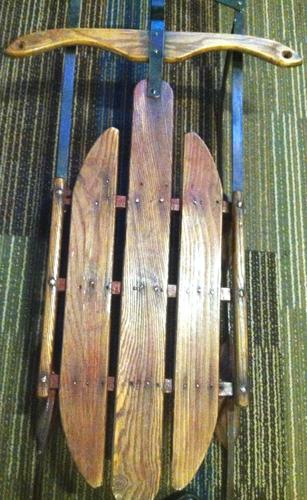No matter your age, getting a new vehicle as a holiday gift is always exciting. New automobiles, motorcycles or bikes are tried-and-true holiday offerings that will thrill a close friend or family member.
While these vehicles stir the senses, two other modes of transportation say “holiday” like no other.
What are the vehicles that prompt both childhood and holiday memories? Sleds and wagons.

This vintage oak sled is from the 1960s-1970s.
Wintery fun
Originally, sleds were among the most efficient ways to transport loads in snowy parts of the world. Sleds facilitated the movement of goods and people on frozen surfaces dating back many centuries. Distinguished by their long and narrow runner blades, sleds reduced friction and were able to carry heavy loads across the miles.
Today, sleds are not used as much anymore for transport, but they are a symbol of wintery fun. More likely, sleds are used by students on snow cancellation days or sleds are transported from the garage to the front porch as part of a winter-welcoming decoration for the house’s exterior.
Many of us recall our favorite wintertime pastime of racing down the hills of our neighborhood on our fastest sleds.
Looking back, the tradition of painted sleds, which boasted hand-colored images of running horses, reindeer packs or Santa Claus, debuted in the Victorian era, circa the mid- to late 1800s. These handsome sleds were used for fancy winter trips for children and adults.
Around 1800, a sled for the purpose of carrying people was invented. It was known as a cariole. A cariole featured enclosed sides, a sturdy back and a partially covered top or hood.
On the secondary antiques market, special 19th-century examples of hand-painted sleds with metal runners and cariole sleds range in value from $250 to $2,500.
Over time, sleds were used for recreational purposes, with variations on the basic form. One of the first sled patents was obtained by the S. L. Allen Co. of Philadelphia in 1889. When it comes to the engineering behind recreational sleds, most had flat runners until about 1907, and then wooden bumpers emerged. An articulated bumper for steering was introduced in 1928 and straight runners were all the rage until the mid 1930s.
One model, called the Lightning Speedster, had a rounded wooden front for easy turning by children sledding during its time of manufacture, circa 1939-42.
By the mid-20th century, speed was king as indicated by the Speed King and Radio Flyer sleds — which were all about fast-moving wintertime fun.
In the American suburbs of the 1950s thru the 1970s, many companies introduced cool sleds for hilltop exhilaration.
For instance, in the 1970s, the Radio Flyer Co. marketed the Ski Sled, which was intended for adults. The sled had a hand brake for safety, which made parents happy — but kids rarely used — and two skis beneath the raised seat for a ride that simulated skiing. The two skis allowed for edge turns and the sled gave a ride that was like experiencing the giant slalom.

Vintage sleds are of interest to collectors.
Wagon comfort
Where sleds offered speed, wagons provided comfort. Wooden wagons were some of the most inviting vehicles for children of the 20th century.
Wagons allowed kids to carry their most important treasures with them wherever the holidays took them. Toys, security blankets, teddy bears and even baby sisters were hosted in a child’s new — and preferably red — holiday wagon.
Originating in the early years of the 1900s, Radio Flyer’s little red wagons remain a favorite with kids. The company was started by Antonio Pasin, an Italian immigrant. Pasin started the firm with the introduction of the Liberty Coaster wagon, named for the Statue of Liberty. His firm grew throughout the 20th century to make Radio Flyer wagons known to millions of children.
Radio Flyer’s red wagon became a popular favorite and common gift at holiday time for good girls and boys. Today, they show up at yard sales, estate sales and auctions and bring good market value from collectors and sentimental shoppers.
By the 1950s, the red wagon became an iconic American toy vehicle. At that time, Radio Flyer wagons were marketed to specialty audiences, such as by the Mouseketeers to the audience of TV’s “Mickey Mouse Club,” or to adventurous kids who wanted to ride in a Davy Crockett-style wagon.
Steiff, the popular German toy and teddy bear manufacturer, made wagons featuring their teddy bear logo to accommodate every child’s holiday gift haul of toys. This marketing strategy helped the collectibles market for the wagons, prompting many collectors to add them to a long list of must-haves.
By the end of the 1960s, Radio Flyer had turned 50, and introduced the Skat Racer to a dedicated audience.
The Skat Racer was a new children’s vehicle that offered innovations where the earlier pedal cars fell short. Kids of the trendy 1960s and 1970s could, in a Skat Racer, enjoy a lightweight design, a safe ride and a sleek new look. This vehicle was a perfect addition to the host of cool kid toys parked in many suburban America garages.
Move over pedal cars: Sleds and wagons are making a comeback.
Happy holidays!
With a Ph.D. from Penn State University, Lori Verderame is an antiques appraiser, author and award-winning TV personality who has appeared on the TV shows “The Curse of Oak Island” and “Pawn Stars Do America.” You can watch her “Real Bargains” show at YouTube.com/DrLoriV. She gives appraisal information at DrLoriV.com or call 888-431-1010.






 ERIN NEGLEY | Staff Writer
ERIN NEGLEY | Staff Writer![Dr. Lori: 1960 JFK campaign memorabilia lures collectors [antiques column]](https://bloximages.newyork1.vip.townnews.com/lancasteronline.com/content/tncms/assets/v3/editorial/5/6a/56a3f260-79c6-11ee-9e7b-bbf7d58802b9/654413c5e038d.image.jpg?crop=1189%2C1207%2C23%2C416&resize=197%2C200&order=crop%2Cresize)

![Dr. Lori: These are sunny days for weather collectibles [antiques column]](https://bloximages.newyork1.vip.townnews.com/lancasteronline.com/content/tncms/assets/v3/editorial/1/95/195df2fa-645b-11ee-aa09-1f03714dca33/6520249b45cd0.image.jpg?resize=150%2C138)
![Dr. Lori: How to know whether your jade is authentic [antiques column]](https://bloximages.newyork1.vip.townnews.com/lancasteronline.com/content/tncms/assets/v3/editorial/5/f4/5f4c6694-484e-11ee-8a12-03513aad05f6/64f11529d12ca.image.jpg?resize=150%2C101)
![Dr. Lori: Not all green stones are valuable jade [antiques column]](https://bloximages.newyork1.vip.townnews.com/lancasteronline.com/content/tncms/assets/v3/editorial/a/e1/ae169392-32d4-11ee-a5e4-e34788ee63c7/64cd0e0c72b7c.image.jpg?crop=1008%2C1028%2C2%2C43&resize=196%2C200&order=crop%2Cresize)


